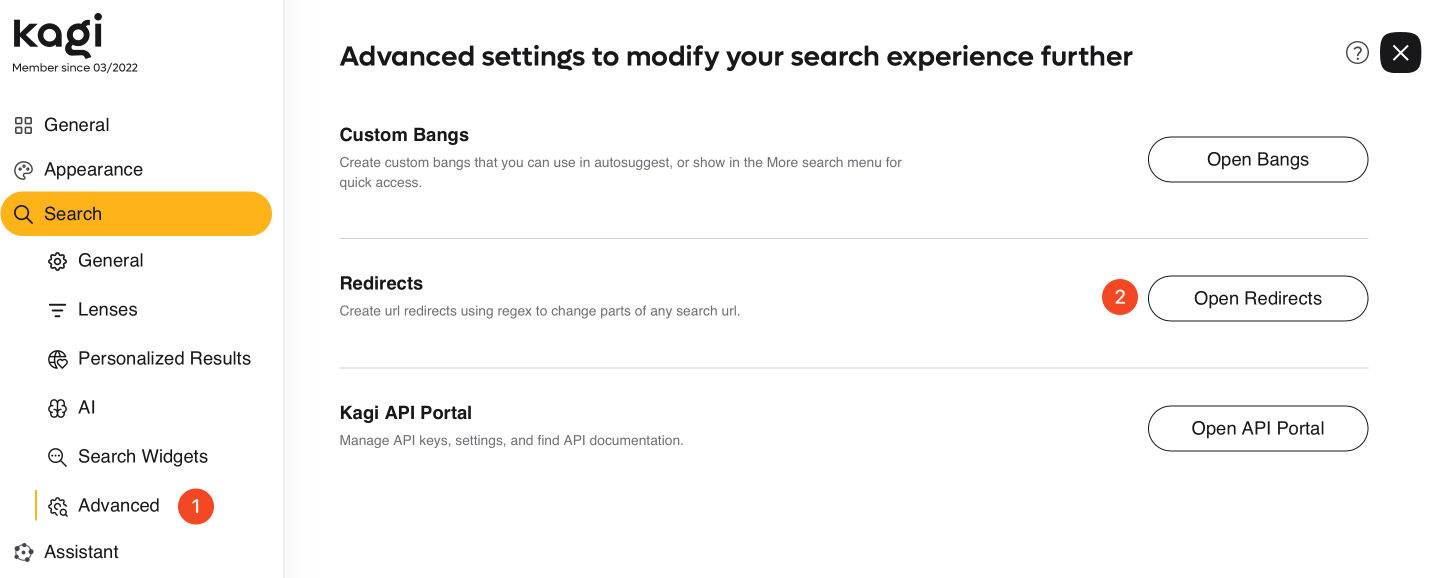Redirects (URL Rewrites)
Redirects are a powerful feature that allow you to make modifications to search result URLs with textual find & replace.
Some use cases of redirects include:
- Change domains to a preferred domain (
reddit.comtoold.reddit.com) - Fixing links to outdated documentation with bad SEO
- Rewriting proxied pages (like Google AMP) to their source URL
- Changing any
httplink tohttps
Managing Redirects
You can manage redirects in your Advanced settings menu, under Redirects.

This will open the Redirects Settings Page:

You can edit an existing Redirect by pressing the pencil icon .
You can delete a Redirect by clicking the trash icon .
To create a new Redirect, press the Add Rule button on the Redirects settings page. This will open a form with instructions and some examples to get you started.

Appearance in Results

Results that have been modified by a redirect will have a indicator to show that they were modified by one of your rules.
You can click this icon to open the rule that modified the URL.
By hovering on this icon, a tooltip will appear showing you the original URL.
Redirect Syntax
A redirect looks like this:
It is composed of the following parts:
- The regex match pattern
- A pipe (
|) separator character - The replacement pattern
The match pattern is written using Regex, a standard language for pattern matching sequences of text. The specific type of regex that we use is PCRE.
The replacement pattern is a verbatim string that will replace the entire URL.
You can use $1, $2, and so on in the replacement pattern to refer to capture groups in the match pattern, to retain parts of the original URL. Capture groups in regex are parts of the pattern that are enclosed in parentheses ().
For every URL on the page that matches the match pattern, a replacement will be triggered using the replacement pattern.
Regex Help
If you've never used regex before - and even if you have - regex can be hard to get right!
Here are some resources to help you write and understand regex:
- Regex 101, a sandbox for writing and testing regex
- QuickREF.ME - Regex Cheatsheet, a quick reference on regex syntax
If you still need help, consider joining our Discord server. Our community members and staff will be happy to help!
Examples
Changing a domain
We can make all https://reddit.com links change to https://old.reddit.com using a rule like this:
^ matches the start of the URL. This will stop the rule from matching a URL that has the domain elsewhere in the URL.
http://reddit.commatches exactly this text.https://old.reddit.com is the replacement.
In this example, because our replacement pattern did not alter the original URL's path, Kagi will keep the original path for you.
See the Safety section for more details.
Changing part of a path
Some documentation websites put a version number in the path of the URL. Sometimes this version number can be outdated in search indexes, so we can use a redirect to help us here.
In this example, we will detect any URL like the following:
https://docs.rs/tokio/0.2.22/tokio/fn.spawn.htmlhttps://docs.rs/smol/1.2.5/smol/struct.Async.htmlhttps://docs.rs/sqlx/0.3.0/sqlx/index.html
and use a replacement to change the version number to the word latest.
This can be done with a single redirect like this following:
This example is a bit more complex, so we will walk through each part.
Match Pattern
^ matches the start of the URL.
https://docs.rs/ matches the domain of the website.
([^/]+) is the first capturing group. This matches anything up to the next /. This group will be assigned to $1.
(?:[^/]+) is a non-capturing group, indicated by the ?:. This matches anything up to the next /. Because of ?:, it is not assigned to any $.
(.*) is the second capturing group. This matches everything that follows, to the end of the URL. This match will be assigned to $2.
Replacement Pattern
https://docs.rs writes the domain.
$1 copies from the first capture group.
latest writes in the word "latest".
$2 copies from the second capture group.
Conclusion
Given the rule:
Will match:
And the replacement will make:
Safety
Redirects have a few "safety" features to help make your redirects simpler, and to prevent the URL from becoming unusable.
When possible:
If your rewrite pattern does not alter the path of the URL, the original path will be retained.
If your rewrite pattern does not include a scheme (
http,https), it will use the original URL's scheme.If your rewrite generates a URL without a host or a path (i.e., empty), it will not be replaced.
If your rewrite generates a URL without query parameters, it will use any query params from the original URL.
For example, this means the reddit example can also be simplified like this:
and it will work the same way.
Query Parameters
Note that redirects do not currently support fully removing query parameters (safety feature #4 above).
This is part of an intentional effort to simplify the redirect rule syntax, essentially doing the following:
- Did the original URL have query parameters?
- Are there no query parameters on the rewritten URL?
- Then, transfer the original parameters onto the rewritten URL.
For example, the following rule does not remove the ?ref=bar query param, despite the regex suggesting otherwise:
rule: ^(https?:\/\/|)([^\?]*).*$|$1$2
original: https://example.com/foo?ref=bar
redirect: https://example.com/foo?ref=barTo work around this, you can hardcode your own query params in the replacement string e.g. by appending ?=:
rule: ^(https?:\/\/|)([^\?]*).*$|$1$2?=
original: https://example.com/foo?ref=bar
redirect: https://example.com/foo?=Related discussions: